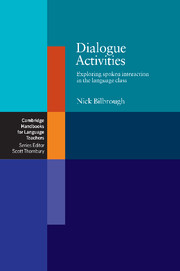Book contents
- Frontmatter
- Contents
- Thanks and acknowledgements
- Introduction
- 1 Understanding
- 2 Analysing
- 3 Reproducing and reconstructing
- 4 Memorising
- 5 Rehearsing and performing
- 6 Co-constructing
- 7 Creating and personalising
- 8 Communicating
- 9 Dialogue as learning
- Dialogue Bank A From the film Mulholland Drive
- Dialogue Bank B Authentic snippets
- Dialogue Bank C Snippets from fairy tales
- Dialogue Bank D Lame jokes
- Dialogue Bank E Situational dialogues
- Dialogue Bank F ‘Dating Agency’ from the comedy series Little Britain
- Further reading and resources
- Index
7 - Creating and personalising
Published online by Cambridge University Press: 06 July 2010
- Frontmatter
- Contents
- Thanks and acknowledgements
- Introduction
- 1 Understanding
- 2 Analysing
- 3 Reproducing and reconstructing
- 4 Memorising
- 5 Rehearsing and performing
- 6 Co-constructing
- 7 Creating and personalising
- 8 Communicating
- 9 Dialogue as learning
- Dialogue Bank A From the film Mulholland Drive
- Dialogue Bank B Authentic snippets
- Dialogue Bank C Snippets from fairy tales
- Dialogue Bank D Lame jokes
- Dialogue Bank E Situational dialogues
- Dialogue Bank F ‘Dating Agency’ from the comedy series Little Britain
- Further reading and resources
- Index
Summary
As in the previous chapter, the activities in this section encourage the learners to plan and script dialogues through working from some form of stimulus. Here, however, the learners are given more freedom in terms of the content and the direction of the discourse they develop. When learners centre the dialogues on topics which they themselves choose, and when they construct them along lines that they themselves decide, the dialogue is likely to be both more meaningful and memorable. More memorable, too, will be the individual words and phrases that they insert into their dialogues.
When learners work in pairs or small groups to create a dialogue there is a useful balance of controlled versus less controlled language use. There is a measure of control which is motivated by the need to jointly produce a final product that is both accurate and appropriate. Explicit peer teaching is often a feature of this type of activity, and learners can also simply ‘pick up’ a lot of language from those they are collaborating with.
At the same time, learners bring their existing language skills and knowledge to the process and there is a freedom to draw on all of this in order to create the most appropriate dialogue. There should also ideally be a certain amount of debate and free discussion as learners try to agree on the context in which the dialogue will occur, and the relative merits of including particular language items.
- Type
- Chapter
- Information
- Dialogue ActivitiesExploring Spoken Interaction in the Language Class, pp. 155 - 169Publisher: Cambridge University PressPrint publication year: 2007



